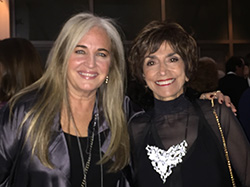SDSU Alumni Enjoying Awards Season
SDSU alumni Kathleen Kennedy and Darla Anderson have both recently won prestigious film awards.

Eight-time Academy Award nominee, Kathleen Kennedy (‘75), a standout filmmaker in Hollywood for more than three decades, recently accepted the prestigious Cinematic Imagery Award at the 22nd Annual Art Director’s Guild (ADG) Awards Spotlight “Production Design: Celebrating 100 Years of Imagination” in Los Angeles.
The award is given annually to someone whose work visually enhances the movie-going experience. George Lucas, Steven Spielberg and Martin Scorsese are among the previous recipients.
Kennedy has either produced or executive produced more than 70 films, including “Back to the Future,” “Jurassic Park,” “E.T. The Extra Terrestrial,” “Lincoln” and most recently “Star Wars: The Last Jedi.” She is the president of Lucasfilm and oversees the company’s three divisions: Lucasfilm, Industrial Light & Magic and Skywalker Sound.
“Ms. Kennedy is truly a significant role model,” said Nelson Coates, ADG president. “Her creative legacy and professional journey is an inspirational example to all young artists who are in search of a meaningful career in the entertainment industry.”

Darla Anderson and Joyce Gattas, dean of the College of Professional Studies and Fine Arts
Darla Anderson (‘82) was one of the young artists who turned to Kennedy for inspiration. A fellow SDSU graduate, Anderson now works as a producer at Pixar Animation Studios and most recently produced “Coco,” which won Best Animated Motion Picture at the 2018 Golden Globe Awards.
In addition to the success at the Golden Globe Awards, Anderson also received the Advanced Imaging Society’s Harold Lloyd Award for Filmmaking.
Since joining Pixar in 1993, Anderson has produced fan favorites like “Toy Story 3,” “Monsters, Inc.,” “Cars” and “A Bug’s Life.”
The awards come at a time when SDSU research shows that women are still largely underrepresented in the film industry.
The 20th annual Celluloid Ceiling report, released earlier this year by SDSU’s Center for the Study of Women in Television and Film, shows that only one percent of 2017’s top grossing films employed 10 or more women in key behind-the-scenes roles, while 70 percent of films employed 10 or more men.
“While the public dialogue regarding the issue has increased over the last two decades, the numbers have yet to reveal any significant movement in employment patterns,” said Martha Lauzen, executive director of the Center for the Study of Women in Television and Film and author of the Celluloid Ceiling report.



